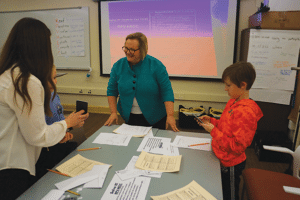In the following interview with the author, Peggy Schaefer Whitby discusses mathematical word problem solving, the Solve It! approach to teaching math word problem solving, and how she applied the approach to students with Autism Spectrum Disorder.
Solve It! Teaching Students with Autism Spectrum Disorder How to Solve Math Word Problems
Interview with the Author
Dr. Peggy Schaefer Whitby is the author of Solve It! Teaching Mathematical Word Problem Solving to Students with Autism Spectrum Disorder. As an advocate for students with autism spectrum disorder (ASD), she is committed to helping students who should be productive in math problem solving but are not—such as her student who could change software code but who was at risk of failing math because he could not solve word problems—succeed. She believes Solve It! is an effective approach to help students with ASD share their many talents with society.
Math Word Problem Solving and Students with ASD
Exinn: Solve It! originally was validated on students with learning and math disabilities. It also was found to be effective in inclusive classrooms that included students who were average performing, low performing, and who had learning disabilities. What interested you in Solve It! for students with ASD?
Dr. Schaefer Whitby: I was working with Dr. Mary Little at Central Florida University, who was conducting professional development on Solve It! in a local school district. She asked me to analyze the data she was collecting on the efficacy of Solve It! I was impressed with the success of Solve It! in teaching students in math word problem solving. As I delved into the Solve It! literature, I saw its potential in supporting the executive functioning needs of students with ASD. The Solve It! process could help students with ASD organize themselves, shift their attention to relevant information, hold information in working memory while manipulating numbers, and encourage their follow through. Given some of the unique strengths students with ASD may have (e.g., preference for routine, visual learning skills, rote memory skills, and good computational skills), I felt that Solve It! would be a good fit.
Math Word Problem Solving and ASD Considerations
Exinn: When you began developing instructional accommodations to support students with ASD in math word problem solving, what things did you consider?
Dr. Schaefer Whitby: The literature suggests that cognitive strategies can be beneficial to students with ASD. However, sometimes students don’t apply correct strategies or have learned strategies that are incorrect. The language and math skills that math word problem solving requires often are identified as challenges for students with ASD.
Thus, you need to find ways to make the steps in Solve It! even more explicit than they already are. For example, students with ASD may not understand schematic representation, which makes the Visualization step difficult. Students also may have difficulty with pronouns, inference, and understanding the main idea, which can make the Read step difficult. Also, you must provide a relevant rationale for the Estimation step because students with ASD often want exact details. Even the Paraphrase step can be tricky, because some students believe that everything is important—they don’t believe that a teacher would ever put out anything that is not important! Making the Solve It! steps explicit, it turns out, also makes math word problem solving more successful.
Why Use Solve It! for Math Word Problem Solving?
Exinn: How do you address motivation to learn the Solve It! process?
Dr. Schaefer Whitby: It is important to understand that students struggle with math word problem solving. Solve it! is based on what good problem solvers do. Thus, when they learn Solve It! and have success, it is reinforcing for them. Because students with ASD tend to have good memorization skills, the Solve It! process is easy to learn—another reinforcer. I also start with one step problems which are easier to solve so that students see immediate success.
Scaffolding support is an important technique. I have organized Solve It! lessons around an “I Do,” “We Do,” “You Do” structure that supports student success for mathematical word problem solving.
Exinn: You introduced strategies into the Solve It! instructional approach that help students with ASD generalize it.
Dr. Schaefer Whitby: One thing to keep in mind is that Solve It! is an evidence-based approach that applies across all problems. So, students do not have to learn other approaches or decide which approach to use when performing math word problem solving. In addition, I embedded instructional strategies such as procedural facilitation, that explicitly support generalization (e.g., have students write the Solve It! acronym down the side of their activity sheets and check off each step as they complete it; ask students to watch a video academic story; let students review student cue cards prior to math class and assessments).
More About the Author
Read more about Dr. Schaefer Whitby’s research and work with Solve It! at https://researchfrontiers.uark.edu/teaching-students-with-autism-to-solve-mathematical-word-problems/
Click here to order Dr. Schaefer Whitby’s Solve It! approach for students with ASD .
Dr. Shaefer Whitby is an associate professor at the University of Arkansas and serves as the program coordinator for special education. She is well-published in the field of autism spectrum disorder and conducts professional development for school districts. Contact Dr. Schaefer Whitby at pschaefe@uark.edu




